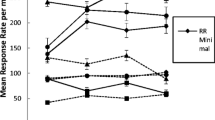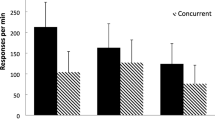Abstract
In a discrete-trials procedure, adult humans chose between two sequential fixed-ratio (FR) schedules. Points, later exchangeable for money, were given for the completion of each FR. When each sequence produced two points for an equal number of responses overall, the value of the first FR in a sequence did not affect choice. When the values of the first FR in each sequence were equal, subjects preferred the alternative with the smaller second FR. Once a preference was established for the alternative with the smaller overall response requirement, two points were given for completing the second FR of the nonpreferred sequence. This sequence then provided three total points. Preference immediately shifted to the alternative requiring more responses overall (and per point) but offering more points.
Similar content being viewed by others
References
BLAIR, W. C. (1958). Measurement of observing in human monitoring. Science, 128, 255–256.
CATANIA, A. C. (1963). Concurrent performances: A baseline for the study of reinforcement magnitude. Journal of the Experimental Analysis of Behavior, 6, 299–300.
CHUNG, S. H. (1965). Effects of delayed reinforcement in a concurrent situation. Journal of the Experimental Analysis of Behavior, 8, 439–444.
DEVILLIERS, P. (1977). Choice in concurrent schedules and a quantitative formulation of the law of effect. In W. K. HONIG & J. E. R. STADDON (Eds.), Handbook of operant behavior (pp. 233–287), Englewood Cliffs, NJ: Prentice-Hall.
GREEN, L., FISHER, E. B., Jr., PERLOW, S., & SHERMAN, L. (1981). Preference reversal and self control: Choice as a function of reward amount and delay. Behavior Analysis Letters 1, 43–51.
HALL-JOHNSON, E., & POLING, A. (1984). Preference in pigeons given a choice between sequences of fixed-ratio schedules: Effects of ratio values and duration of food delivery. Journal of the Experimental Analysis of Behavior, 42, 127–135.
HERRNSTEIN, R. J., & LOVELAND, D. H. (1975). Maximizing and matching on concurrent ratio schedules. Journal of the Experimental Analysis of Behavior, 24, 107–116.
LIPPMAN, L. G., & MEYER, M. E. (1967). Fixed-interval performance as related to instructions and to subject’s verbalizations of the contingency. Psychonomic Science, 8, 135–136.
NAVARICK, D. J., & FANTINO, E. (1976). Self-control and general models of choice. Journal of Experimental Psychology: Animal Behavior Processes, 2, 75–87.
NEURINGER, A. J. (1967). Effects of reinforcement magnitude on choice and rate of esponding. Journal of the Experimental Analysis of Behavior, 10, 417–424.
POLING, A., BLAKELY, E., PELLETIERE, V., & PICKER, M. (1987). Choice between sequences of fixed-ratio schedules: Effects of ratio values and probability of food delivery. Journal of the Experimental Analysis of Behavior, 47, 225–232.
POPPEN, R. (1982). The fixed-interval scallop in human affairs. The Behavior Analyst, 5, 127–136.
RACHLIN, H., & GREEN, L. (1972). Commitment, choice and self-control. Journal of the Experimental Analysis of Behavior, 17, 15–22
SCHWARTZ, B. (1969). Effects of reinforcement magnitude on pigeons’ preference for different fixed-ratio schedi les of reinforcement. Journal of the Experimental Analysis of Behavior, 12, 253–259.
WEINER, H. (1962). Some effects of response cost upon human operant behavior. Journal of the Experimental Analysis of Behavior, 5, 201–208.
WEINER, H. (1969). Controlling human fixed-interval performance. Journal of the Experimental Analysis of Behavior, 12, 349–373.
Author information
Authors and Affiliations
Additional information
The reported research was partially supported by National Institutes of Health Grant NS20217.
Rights and permissions
About this article
Cite this article
Blakely, E., Starin, S. & Poling, A. Human Performance Under Sequences of Fixed-Ratio Schedules: Effects of Ratio Size and Magnitude of Reinforcement. Psychol Rec 38, 111–119 (1988). https://doi.org/10.1007/BF03395009
Published:
Issue Date:
DOI: https://doi.org/10.1007/BF03395009




